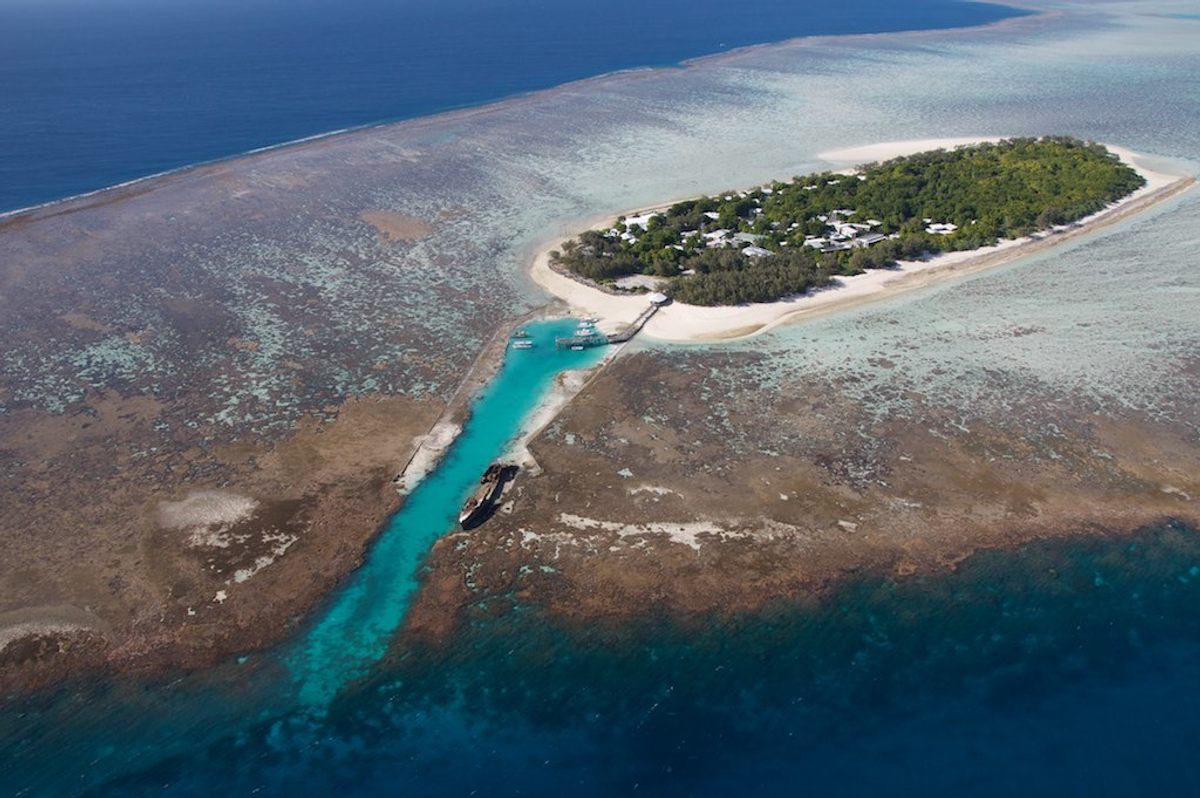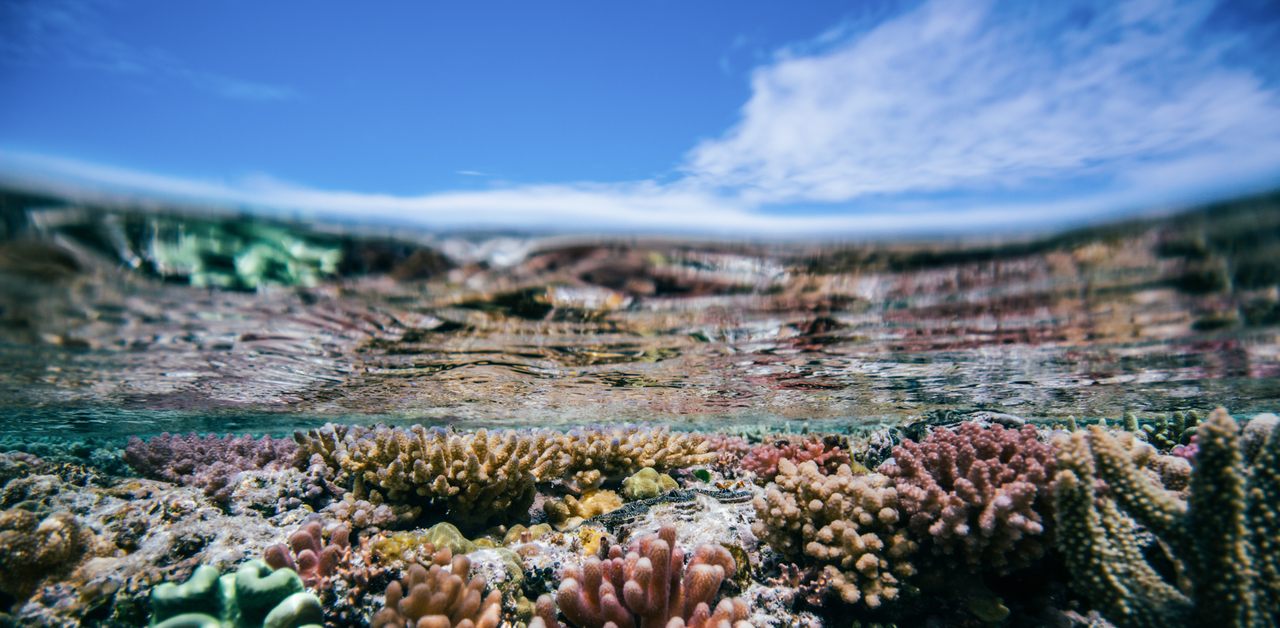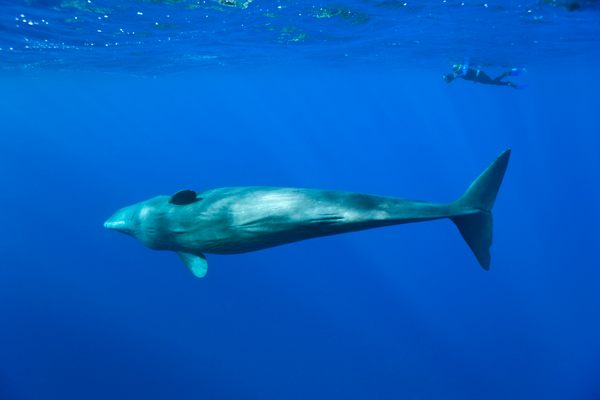How Do Stressed-Out Corals Smell?
The answer could help researchers detect bleaching events before they happen.
If you are ever moved to be needlessly cruel to someone hunkered down for the winter in a dull, drafty place, you might send them a picture of Heron Island. A lush, sand-fringed freckle several hours by boat from Gladstone, Australia, it looks like a screensaver version of paradise. Adorably dour-looking black noddies perch in Pisonia trees; green and loggerhead turtles stumble from the turquoise water each year to bury their eggs in the sand. But the most astonishing feature of the island is offshore—a portion of the Great Barrier Reef.
Pocillopora damicornis, sometimes known as the “cauliflower coral,” is lumpy and brownish, like an unfortunate brassica left to rot in remote reaches of the fridge. Colonies of Acropora intermedia huddle together in stands several yards across, their creamy branches resembling a pianist’s agile, elegant hands. The reef is famously struggling in the face of warming waters. In a new report, the International Union for Conservation of Nature categorized the reef’s outlook as “critical,” the most dire prognosis the group issues. That diagnosis was due in part to bleaching, which occurs when coral expels its symbiotic algae.
Many healthy coral polyps are packed with zooxanthellae, a single-celled, photosynthetic algae that provide the corals’ major food supply, as well their hue. Algae funnel glucose, amino acids, and other byproducts of photosynthesis to reef-building corals, and corals use those to fuel production of calcium carbonate, the substrate of the reef. When water temperatures rise (or, sometimes, plunge), the algae bolt, leaving wan corals in their wake. “The animal tissue is naturally transparent, like a jellyfish, so you see straight through to the white skeleton when the chlorophyll pigments in the algae are gone,” says Carly Kenkel, a biologist at the University of Southern California Dornsife. The Great Barrier Reef has seen three mass bleaching events in the last five years, according to a report by Australia’s Great Barrier Reef Marine Park Authority. Such occurrences aren’t necessarily death sentences—reefs can bounce back if algae return—but losing them even temporarily can be both a response to stress and mighty stressful itself, leaving corals more vulnerable to disease.

We know that stress makes humans sick, slick, and stinky, and stressed-out corals smell different, too. Of course, heat stress doesn’t make coral sweat, but it does change the type and composition of the gases known as biogenic volatile organic compounds (BVOCs) that rise off the reef. A team led by Caitlin Lawson, a researcher at the University of Technology Sydney, recently chiseled some samples of P. damicornis and A. intermedia from the Great Barrier Reef near Heron Island to gauge the effects of heat stress on those gases: the smell of a reef under threat.
Many researchers who work with coral aren’t in the business of sniffing it. They take samples underwater, noses covered by SCUBA masks, and return to shore or a boat without stopping to take a whiff. After collecting tropical coral samples, “I’m immediately plunging the coral piece into a dewar of liquid nitrogen to flash freeze it or into a tube of saturated salt to preserve it,” says Christina Kellogg, a research microbiologist at the U.S. Geological Survey’s St. Petersburg Coastal and Marine Science Center in Florida. “In both cases, speed is of the essence to stop the clock on the microbial diversity, so I have never registered the smell.”

Kenkel describes the smell of live corals as mild and briny, like fresh oysters. Things get funkier if the coral has bleached, or if it sits out of the water and produces mucus. Removing coral from its natural environment is a stressor in and of itself, so by the time someone smells a nubbin—a fragment no larger than a couple of polyps—it’s already struggling a little. “Whenever I can smell them, it’s when they’re out of the water, or I’m starting to stress them out,” says Lawson.
The compound most commonly associated with corals is dimethyl sulfide, which phytoplankton generate and unleash into the atmosphere. The scent is often likened to rotting cabbage. “It’s not the most pleasant smell,” Lawson says. “If you’ve walked along a beach at low tide when there’s seaweed exposed, it’s quite similar to that. But rotting cabbage is probably a bit harsh.”
To measure the ways that the samples’ gases changed under heat stress, Lawson and her collaborators used tanks containing healthy, recently harvested samples, and then inched the temperatures up by 4.5 degrees over five days, until the water reached 32 degrees Celsius (89.6 degrees Fahrenheit), a temperature at which bleaching is known to occur.
In the artificially warmed waters, P. damicornis and A. intermedia produced fewer BVOCs than their control-sample counterparts, and the ones they did emit were present in lower amounts. When temperatures were held at 32 degrees C, the team noted a downturn in overall health, and even spotted some bleaching. Walking around the lab, Lawson didn’t smell anything different but that doesn’t mean the smellscape stayed the same. “If [the corals are] paling, there’s a corresponding change in the gases,” she says. The team published their findings in Global Change Biology.
“It’s a fascinating paper,” says Bryan Wilson, a marine biologist at University of Oxford who studies corals. Wilson, who wasn’t involved in this research but advised one of the coauthors on past work, appreciates the paper’s focus on “a relatively understudied component of coral biology,” and hopes that future studies will examine keystone species and ones that are known to be more heat-tolerant.
He’s also excited about the possibility that this research could eventually help scientists diagnose threatened reefs. Lawson hopes to explore whether there are specific compounds that are precursors to visible bleaching, and that has Wilson really jazzed. “The biological prediction of bleaching events prior to the observed symptoms of coral stress is something of a Holy Grail in the field,” Wilson says. Eventually, we may not have to wait for corals to turn ghostly white to know they’re in trouble—with the right tools, we might be able to smell their distress before we see it.


















Follow us on Twitter to get the latest on the world's hidden wonders.
Like us on Facebook to get the latest on the world's hidden wonders.
Follow us on Twitter Like us on Facebook